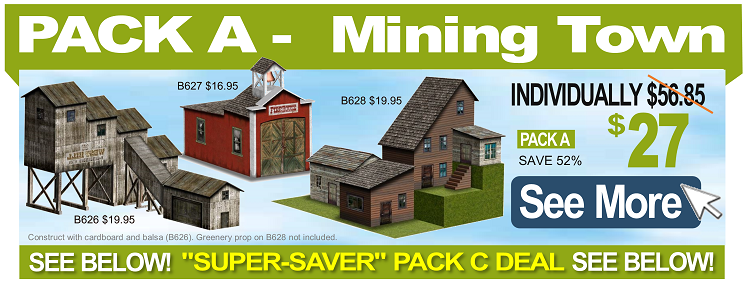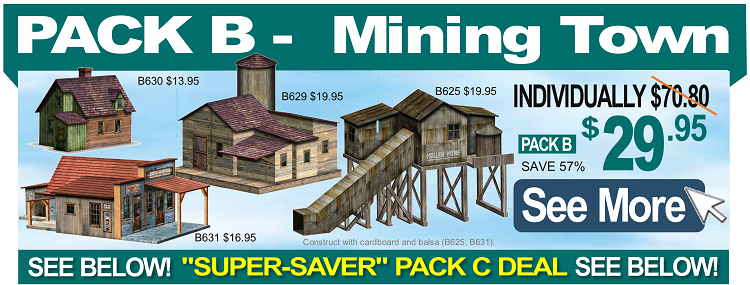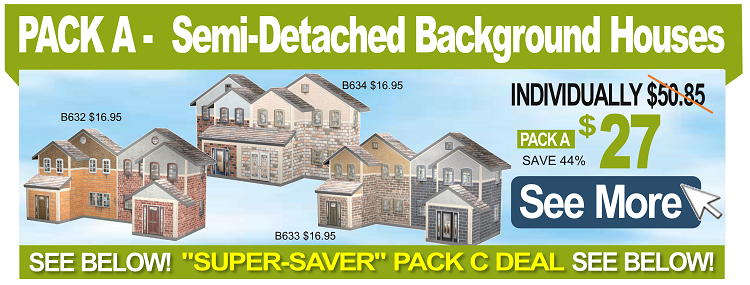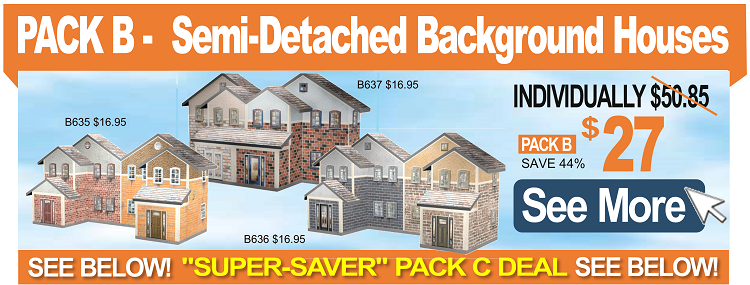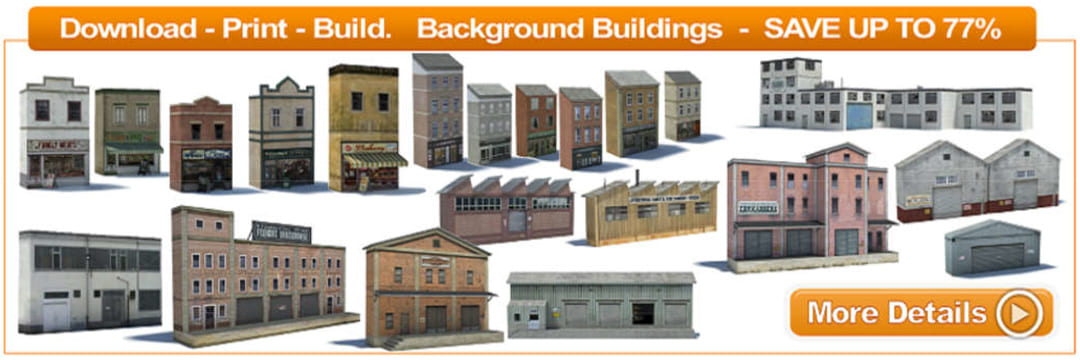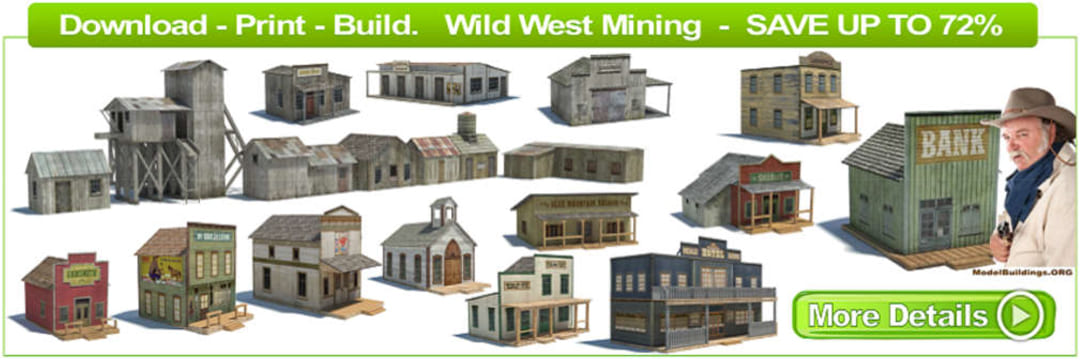Download “Remarkably Realistic” Paper Model Buildings
for Railroad Layouts. Strong, Long Lasting, and Durable
When Assembled with Cardboard or Corflute.
Grab Your FREE CATALOG for making
paper models from the Home Page
If you like making dioramas or creating scenery for your train layout, then have a good look around this. It contains a large selection of printable paper model buildings which can be constructed for HO scale layouts, as well as N scale, or to OO scale if you live in the UK. After a good look around you’ll see this site also contains a series of useful demonstration videos, some free calculators for railroaders, and several train room posters to download free of charge. You’ll also discover the wide variety of plans for making paper model buildings. Each is beautifully detailed with careful attention to accuracy and minute details. These paper models are quick to download and look superb (and super strong) when assembled,
A great many people are intrigued by paper model buildings and how good they are for bringing a level of quality and realism to scenery on a railroad layout. The reason for the “true-to-life” look is due to the photographic images used on many of the scale models. The paper models which you can download from this website are not like illustrations, drawings, or graphics – they actually resemble photographic images, so can be used like printable color templates that replicate real lifelike structures. You just can’t achieve the same level of authentic realism and originality with plastic kits.
Unmatched Realism With “Fun to Make” Paper Model Buildings
Have a look through the plethora of amazing printable paper models available for sale on this website. Not only are they fun and practical to construct, they are also incredibly durable and strong when assembled using cardboard from cereal boxes, sometimes corflute, and even balsa wood painted with acrylic paints for post and chimney construction. What’s more, the plans for these railroad buildings are easy to extend, add to, and modify to suit the unique requirements of your train layout scenery or diorama scene.
The above picture shows some of the range of background structures that can be downloaded and constructed from inexpensive corflute board. They get printed on paper (regular photocopy works better than expensive alternatives), and glued to some corflute or foam board. This process makes the models amazingly strong, just like plastic kits but without the expensive price tag. So it is feasible to construct multiple scale railroad buildings for the cost of just one or two plastic models. And, the paper models won’t require painting, or skilled weathering to achieve the kind of quality exhibited with these printable plans. That’s not to say that plastic kits are a waste of money, you just need to be aware of the higher cost and additional work and skills required to construct them to a high standard.
Select From More Than 200 “Unique” Designs of Paper Models
Not only are these designs very sturdy when put together with card, there is also an incredible variety of downloadable plans to select from and buy. The above old west and mining town models are an example of the variety templates that can be downloaded. They can be put together with paper, card, and balsa wood can be used for the thin post supports. All those materials are inexpensive and readily available at art and craft hobby stores. The cardboard can be card from cornflake packages, so that will save you throwing the old packs in the trash. Extra card can be glued inside assembled buildings if necessary to provide additional strength. These printable paper models are particularly suitable for OO gauge railways and HO scale railroads, but there is also the option at the checkout to buy N scale versions. So, with that in mind lets talk a bit about that size of train layout.
Deciding on N scale has numerous attractions, but possibly the biggest draw is the small size when compared to larger scales like HO, OO, and O. Although N scale (1:160) is not the smallest (1:220 Z scale and the tiny 1:450 T scale are much smaller), N scale does allow for a considerable amount of track, scenery, and train operation in a relatively small space. This is a big advantage for anyone who has limited room available. Prototypical (real) length trains of around 100 cars can operate in N-Scale.
N scale products began appearing in about 1962. The first locomotives were quite crude and ran poorly. As with most products, either consumer demand drives improvements or consumer apathy eliminates the product from the market. Fortunately, demand has driven huge improvements. It is now possible to buy N-scale products that are every bit as detailed and well-running as any other scale model. Kato, Athearn, and Micro-Trains manufacture beautifully detailed and superbly running locomotives and rolling stock. For those so inclined, super-detailing parts are also available. A good magnifying headband, strong lighting, and a good set of small tools are necessary if a lot of N-scale detailing of rail equipment or structures is to be done. Working on N-scale details is more challenging than a larger scale, but not difficult to master with the proper tools. Surprisingly detailed layouts have been created in about the space of a home coffee table.
N scale models are in fact 54.5 percent the size of similar HO models. The same applies to trains, scenery and paper models. As a result you can build an N scale layout in an area about 30% of that area needed to build a similar layout in HO scale.
Due to its smaller size, N scale is more intricate. For this reason it can be less suitable for youngsters and the more seasoned railroaders who may find it difficult manipulating the small rolling stock. There aren’t as many options in terms of accessories compared to those available in HO Scale but with growing popularity this is changing.
If space is an issue then N scale could be the answer. N Scale allows for more complex and realistic layouts in limited space. Curves can be made much more gradual. The smaller size of N scale greatly reduces the need to utilize unrealistically sharp curves to reverse the direction of the train on a layout.
N scale allows for layouts where the scenic landscape can dominate the railroad as it does in real life. As a comparison; a common-sized 4ft x 8ft layout in HO scale would probably fit into a 2 ½ ft x 4 ½ ft space if it was modeled in N scale.
Make Your Paper Model Buildings To OO Gauge, N Scale or to HO Scale
The printable plans for the paper models sold on this website are also suitable for OO gauge and HO scale. Being easily printed out on a home printer is handy because they can be conveniently reduced in size if required. It is just an easy matter of adjusting the settings on the printer. The reason why many railroaders choose this option is because they can place some smaller background buildings against the backdrop to give the illusion the printed paper models are miles away in the distance. So, as you can see, these paper building models are very versatile and adaptable.
With N scale a three-foot wide layout could accommodate up to a 213 scale foot radius. The smaller N scale is also more accommodating to larger quantities of cars in a train. So, if you like the idea of long trains going through towering landscape, then N scale buildings might be what you are looking for.
[expander_maker id=”1″ more=”Load more” less=”Load less”]
Starting off with a smaller space often allows room for later expansion. Constructing a large layout (of any scale) as the first project can be overwhelming. Many modelers start out with great enthusiasm only to realize the enormity of the task they’ve undertaken. This is why N scale can be a better option, rather than underestimating the amount of time and effort needed to build a larger scale layout. After all, there’s no fun in having a partially completed railroad that gets abandoned and left to gather dust. It is often best to start out small and think big. You can still create a perfect replica scene complete with paper model buildings in a small space and expand your scenery at a later date as or when your railroad layout branches out.
N-gauge track is manufactured by several companies in a lot of different configurations, but all will have a gauge separation of nine millimeters between the rails. Nine. Hence the term N gauge. In our model world, nine millimeters represents four feet, eight and one half inches.
If you do some quick multiplication and division, you will discover that 4’8.5” is 1435.1 millimeters (25.4 mm to the inch), and that the US standard gauge for trackage is 159.46 times our nine millimeter N-gauge track. We round that up to the next higher whole number, and come up with a ratio of 1:160, which is the ratio we mentioned earlier, and what we call “N-scale”. Anything in our N-scale world is going to be 1/160th the size of a real object if it is “to scale”. In the UK N scale is slightly different at 1/148.
Authentic Lifelike Photographic Images Make Paper Model Buildings
Closely Resemble True To Life, Full-Sized, Real World Structures
The quality and uniqueness of these printed replicas is unmatched, because they take advantage of highly detailed photographic pictures that show sharp images of minute details including natural rust marks, cracks in concrete and brickwork, naturally weathered timber with flaking paintwork, water stains on walls, and other original and natural features likely to be a component of many real world life-sized structures. The paper models for these 200+ scale buildings are already precisely detailed and weathered to replicate real world life. This not only saves the train enthusiast a considerable amount of time and money, but it also ensures the highest standard of real life realism, unachievable with any other model construction method, unless the hobbyist is highly skilled in airbrushing and finely detailed artistry. Downloaded paper model buildings that utilize photographic styles are hard, if not impossible to beat when it comes to realism and authenticity.
N Scale Sizing Explained
-
- With track, the distance between the rails is 9mm or if you are working in imperial measurements, it is the same as 5/16 inch between the rails. By comparison, HO-scale is 5/8 inch between the rails.
- With locomotives, an N scale diesel engine is approximately 4 inches in length. An HO engine is double that at about 8 inches long.
- With freight cars, a typical N-scale freight car is approximately 3 1/2 inches long. By comparison, an HO scale car measures about 7 inches long. In both N scale and HO, the passenger cars are usually much longer.
- With model buildings, a typical N-scale house door is approximately 1/2 inch in height. An HO-scale door measures twice that at 1 inch tall. The doors for industrial background buildings are usually higher. The paper models here are available in N and HO.
- Figures of people on a layout need to be a bit shorter than the door sizes mentioned above.
- With automobiles, a typical N scale vehicle is just over 1 inch in length. Again, a HO automobile is about double that at 2 inches long.
- With telegraph poles a typical N scale pole is approximately 3 inches tall. In HO the pole would be around 6 inches tall.
How to Construct Paper Model Buildings to Make Each Scale Replica
Strong, Sturdy, and Durable Enough to Last Forever on Your Railroad Layout
Some people wrongly assume that the printable plans for paper models won’t be strong enough to stand the test of time. Fact is; we get emails from model railroaders on a regular basis telling us how impressed they are with the strength and longevity of these scaled-down replicas of real buildings. And, there are several worthwhile assembly and construction techniques to ensure this is the case. Two or three light coats of clear matt artist varnish is a good idea when construction is completed. This will help protect the printed surface of the printed paper model buildings. Also, as with plastic kits, scenery, and trains – keep your paper buildings out of direct sunlight and away from heaters etc. Cereal box card is perfect for constructing most paper models and extra pieces of card can be glued on the inside after construction to give the walls additional support to prevent buckling in extreme conditions. Corflute is an ideal material for background buildings because it is not only cheap to buy, but it is also incredibly sturdy. The other thing is to use plenty of adhesive and spread it evenly on when gluing the printed paper to cardboard or corflute. You don’t want air bubbles to get trapped under the surface.
Deciding your Scale
I know we have spent quite some time explaining the options, but the scale you choose will have a major impact on how your layout will look and operate… and how much enjoyment it gives you.
Naturally, your choice of scale will depend on what you want your railroad to do. It is important to remember that bigger is not necessarily better. You can pack more into the scene with a smaller scale. If you live in an apartment or small house where space is limited, then think about a smaller scale such as Z, N and HO. If you are interested in micro trains, consider Z, which is 1:220.</p.
Selecting what’s best for you
1. Measure the area or table where the train set is going. Consider that it may not be possible to reach more than three feet across a layout, limiting an “against the wall” layout to about three feet wide.
2. Think carefully about who will be using the model railroad and what you want to achieve from your layout.
3. Head to the hobby shop or surf the net for what you want. If you are visiting a store it might be a good idea to take a tape measure.
4. Visiting a hobby shop is a good idea because you can measure out a few pieces of track in each scale.
5. Do the math if you don’t have a tape measure. Sizes are as follows: O track is 1 1/4 inches wide. S track is 7/8 inch wide. HO track is 0.65 inch wide.
6. Decide how much detail you’d like to have on your trains if room is not an issue. Remember; detail is easier to see and reproduce on larger trains.
7. Consider how extensive you intend your layout to be now…. and in the future.
8. See whether the trains and accessories you like are available in every scale or only some scales, and choose accordingly. One big benefit of utilizing paper models in railroad scenery is the versatility of these real life structure replicas. The downloaded plans can easily be reduced in size on a printer to make backdrop buildings appear to be two or three miles away in the distance, or you can print out additional copies of the plans so as to extend a building width.
Explain Narrow Gauge
Narrow gauge equipment maintains the scale, but runs on a smaller gauge of track. It is seldom used on main lines.
Narrow gauge models use the lower case letter “n” to follow the scale and then the track gauge in scale feet. Example: HOn3 means HO scale (1:87 proportion narrow gauge 3 feet between the tracks.). HOn2 would be HO scale narrow gauge 2 feet between the tracks.
Why narrow gauge? Narrow Gauge track was generally laid in areas where rail traffic was light, curves may have needed to be tight, and cost was a major issue. Most popular in mining spurs, logging spurs, and scenic tourist rails where low speeds were usual. A look through the selection of printed paper building models on this website reveals are range of photographic-style plans that are suitable for buildings positioned alongside narrow gauge model railways. There are small sheds, mining town structures etc.
In some locations in the USA, special purpose railroads operated on rails that were less than standard gauge because the equipment could be made to work in tight spaces or places where creating a standard gauge right of way was extremely difficult and/or expensive. These “narrow gauge” railroads were used to haul timber and mined ores, among other things, and several examples live on as tourist attractions featuring historic locomotives and rolling stock. A very common narrow gauge rail separation was three feet, so when you see an “n3” appended to a model railroad gauge, it represents a model whose scale rail separation is three feet. Again, using our math skills, we can see that the actual Nn3 rail separation is going to be around 6 mm. This is very close to the Z-scale separation of 6.5 mm, so Z-scale trackage is sometimes used to model N scale narrow gauge railroads.
Similarly, you might see something like On30, which indicates that the scale rail separation on that O-scale layout represents a real railroad gauge of 30 inches.
Enhance Your Railroad Layout Scenery With Versatile
“True To Life” Paper Model Buildings
We hope you found this helpful. If you are looking to construct some buildings for your railroad layout, then please take a look at the wide variety of paper models on this website. You will find the quality is of the highest standard, and the variety of designs is unmatched anywhere. If on the off chance you don’t find a design to meet your needs, then by all means do have a look at other suppliers such as: Walthers, Revell, HobbyMaster, HobbyLinc, ScaleScenes, Metcalfe Models, Wordsworth Railways, Kato, Kingsway, Hornby, Bachmann, Clever Models, eBay, Amazon and others.
We are just a small supplier in a market crowded with much bigger players, so we certainly try our utmost to offer an excellent selection and to support the railroading community. Your business is very much appreciated and required for us to survive. If we don’t have what you need then we understand you might want to shop elsewhere. However, we would very much like your support so that we can continue on, and hopefully continue to add to our range of download paper models for the model railroading community. Thank you for your support in advance.
Enjoy making your miniature paper model buildings for your train layout and hopefully you will support us and buy from this website. Happy railroading.
[/expander_maker]

